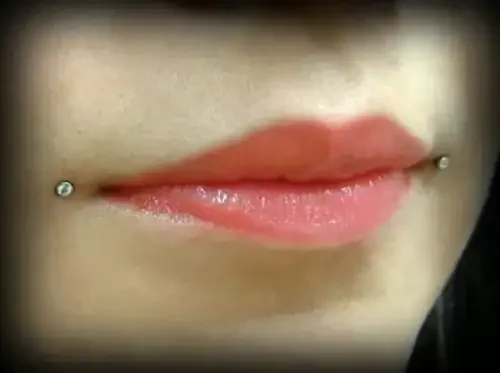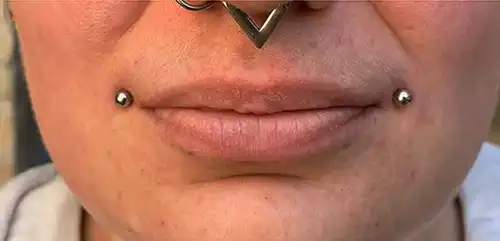Dahlia Piercing
The piercing takes its name from the dahlia flower, which has petals that curve inward, similar to the curve of the piercing. It is typically done with a straight or curved barbell, and the healing process can take several weeks to a few months.
As with any piercing, it is important to find an experienced and reputable piercer who uses sterile equipment and follows proper aftercare procedures to minimize the risk of infection and ensure proper healing. It is also important to consider the potential risks and complications associated with the piercing, such as swelling, pain, scarring, and nerve damage.
Considerations before getting a Dahlia Piercing
Before getting a Dahlia piercing or any facial piercing, there are several important considerations to keep in mind. Taking the time to think through these factors can help you make an informed decision and ensure that the piercing is right for you:
- Professional Piercer: Choose a reputable and experienced professional piercer who is licensed and follows strict hygiene and safety practices. Ask for recommendations, read reviews, and visit the studio beforehand to assess its cleanliness and professionalism.
- Healing Time: Be prepared for a potentially lengthy healing process. Dahlia piercings, like other facial piercings, can take weeks to several months to fully heal. During this time, you’ll need to be diligent about aftercare to minimize complications.
- Pain Tolerance: Consider your pain tolerance level. Facial piercings, including Dahlia piercings, can be uncomfortable during and immediately after the procedure. If you have a low pain tolerance, discuss this with your piercer and be prepared for the sensation.
- Lifestyle and Occupation: Think about your daily activities and occupation. Certain jobs or activities may not be suitable for individuals with facial piercings due to hygiene or safety concerns. Some employers may also have policies against visible facial piercings.
- Jewelry Selection: Consider the type of jewelry you want to wear in your Dahlia piercings. Circular barbells and captive bead rings are common choices, but you’ll want to select jewelry that matches your personal style and comfort.
- Risk Factors: Understand the potential risks and complications associated with facial piercings. Infections, swelling, scarring, and jewelry migration are all possible issues. It’s essential to follow proper aftercare instructions to minimize these risks.
- Commitment to Aftercare: Be prepared to commit to a strict aftercare routine, which may include cleaning the piercings with saline solution, avoiding touching the jewelry with dirty hands, and refraining from oral activities (like kissing or oral sex) during the healing process.
- Allergies and Sensitivities: Inform your piercer of any allergies or sensitivities you have to certain metals or materials used in piercing jewelry. They can recommend hypoallergenic options to minimize the risk of allergic reactions.
- Consultation and Discussion: Have a thorough consultation with your piercer. Discuss your expectations, desired look, and any concerns you may have. Your piercer can assess whether you are a suitable candidate for Dahlia piercings and provide personalized advice.
- Future Plans: Consider your future plans, such as potential job changes or lifestyle adjustments. While Dahlia piercings can be removed if necessary, they may leave scars, so think about the long-term implications.
Dahlia Piercing Procedure
The Dahlia piercing procedure should always be performed by a professional piercer in a clean and sterile environment. Here’s a general outline of the steps involved in the Dahlia piercing procedure:
- Consultation: Before the procedure, you’ll have a consultation with the piercer. During this discussion, you can ask questions, discuss your expectations, choose the jewelry type and size, and address any concerns or allergies you may have.
- Preparation: Your piercer will sterilize their hands and wear disposable gloves to ensure aseptic conditions. They’ll also disinfect the area around your mouth where the piercings will be done.
- Marking: Your piercer will use a surgical marker to mark the exact placement of the Dahlia piercings. It’s crucial to achieve symmetry, so you and the piercer will check the markings in a mirror to ensure you’re satisfied with the placement.
- Piercing: Using a sterilized needle, your piercer will pierce through the marked spots on both sides of your mouth simultaneously. This is typically done quickly to minimize discomfort. Some pain, swelling, and bleeding are normal during and immediately after the procedure.
- Jewelry Insertion: Once the piercings are made, your piercer will insert the chosen jewelry, such as circular barbells or captive bead rings. They will secure the jewelry in place and make any necessary adjustments to ensure it sits comfortably.
- Aftercare Instructions: After the procedure, your piercer will provide you with detailed aftercare instructions. These instructions typically include cleaning the piercing with saline solution, avoiding touching the jewelry with dirty hands, refraining from oral activities during healing, and following a recommended schedule for changing or downsizing jewelry.
- Healing Process: Dahlia piercings can take several weeks to several months to heal fully. During this time, it’s crucial to follow the aftercare instructions diligently to minimize the risk of complications and promote proper healing.
- Follow-up Appointments: Your piercer may schedule follow-up appointments to monitor the healing process and make any necessary adjustments to the jewelry. They can also address any concerns or issues that may arise during the healing period.
Dahlia Piercing FAQ’s
Dahlia Piercing Process
Your initial step should be to locate a professional piercer with dahlia piercing experience. Due of its complexity, this piercing should not be attempted at home. When you get to the piercing shop, the piercer will walk you through the process and have you complete some papers. When they are prepared, your piercer will take you back and clean the sides of your mouth. Your new piercings will be precisely marked with a surgical pen. Before continuing, make sure you like where the marks are placed.
Your mouth will then be punctured with a hollow needle after your piercer clamps it to keep it steady. Your piercer will quickly swap out the needle for your jewellery. The other side will then undergo the same procedure. Your piercer will discuss aftercare with you as a final step and ensure that you understand how to take care of your piercing.
Dahlia Piercing Pain Threshold
The level of pain experienced during a Dahlia piercing can vary from person to person, as pain tolerance is subjective. However, lip piercings, in general, are considered to be moderately painful due to the sensitivity of the area and the thickness of the tissue that needs to be pierced.
During the piercing process, you may feel a sharp or intense sensation as the needle passes through the lip tissue. The pain may also continue for a few minutes afterward and the area may be sore or tender for a few days or weeks as it heals.
It is important to keep in mind that everyone’s pain threshold and healing process are different, and there are steps you can take to minimize pain and promote healing, such as following proper aftercare instructions and avoiding irritants like smoking, alcohol, or certain foods.
Dahlia Piercing Healing and Aftercare Tips
The healing process for a Dahlia piercing can vary from person to person, but it typically takes about 6 to 12 weeks for the initial healing to occur. However, complete healing can take several months or even up to a year, depending on how well the piercing is cared for and how your body responds to the piercing.
During the healing process, you may experience some swelling, redness, tenderness, and discharge from the piercing. This is normal and a part of the body’s natural healing process. To promote healing and prevent infection.
It is important to take proper care of the piercing during this time to promote healing and prevent infection.
Here are some aftercare tips for a Dahlia piercing:
- Clean the piercing regularly: It is important to clean the piercing twice a day with a saline solution or a mild, unscented soap. Avoid using harsh cleaning agents, alcohol-based solutions, or hydrogen peroxide, as they can irritate the piercing and slow down the healing process.
- Avoid touching the piercing with dirty hands: Always wash your hands before touching the piercing. Avoid playing with the jewelry or rotating the piercing, as it can cause irritation and slow down the healing process.
- Avoid irritating substances: Avoid smoking, alcohol, spicy or acidic foods, and other substances that can irritate the piercing and slow down the healing process.
- Avoid submerging the piercing in water: Avoid swimming or submerging the piercing in bodies of water like pools, hot tubs, and lakes. These places can harbor bacteria and increase the risk of infection.
- Be careful when brushing your teeth: Be careful when brushing your teeth or using mouthwash to avoid hitting the piercing.
Downsize the jewelry: After the initial healing period, downsize the jewelry to prevent irritation and promote complete healing. - Monitor the piercing for signs of infection: If you experience any signs of infection, such as excessive swelling, pus or discharge, or severe pain, seek medical attention immediately.
- It is also important to downsize the jewelry after the initial healing period to prevent irritation and promote complete healing.
It is important to follow these aftercare tips to ensure a smooth healing process and prevent complications. If you have any concerns about your Dahlia piercing or its healing process, consult with a professional piercer or a medical professional.
Dahlia Piercing Jewelry Material
When choosing jewelry for a Dahlia piercing, it is important to choose high-quality materials that are safe and less likely to cause irritation or allergic reactions. Here are some recommended jewelry materials for Dahlia piercings:
- Titanium: Titanium is a popular material for piercings because it is hypoallergenic, lightweight, and durable. It is also less likely to cause irritation or allergic reactions.
- 14k or 18k gold: Gold is another popular material for piercings. It is a hypoallergenic material and comes in various shades such as yellow, rose, and white gold.
- Niobium: Niobium is a hypoallergenic metal that is known for its resistance to corrosion and tarnish. It is often used for people with metal sensitivities.
- Platinum: Platinum is a rare and expensive metal that is hypoallergenic and durable. It is a good option for people with metal sensitivities.
- Surgical steel: Surgical steel is commonly used for piercings because it is hypoallergenic, affordable, and easy to find. However, it may contain small amounts of nickel, which can cause irritation for people with nickel allergies.
It is important to choose jewelry made from high-quality materials and avoid cheap or low-quality materials, as they can cause irritation, infection, or other complications. Always choose jewelry that is the correct size and fits comfortably in the piercing.
Dahlia Piercing Jewelry Styles
There are a variety of jewelry styles that can be worn with a Dahlia piercing. Here are some popular options:
- Straight barbell: This is the most common and basic jewelry style for a Dahlia piercing. It consists of a straight bar with balls on each end.
- Curved barbell: A curved barbell is similar to a straight barbell, but the bar is curved to fit the natural shape of the lip.
- Circular barbell: A circular barbell, also known as a horseshoe, is a circular piece of jewelry with balls or spikes on each end.
- Captive bead ring: A captive bead ring is a ring with a ball or bead that is held in place by the tension of the ring.
- Labret stud: A labret stud is a piece of jewelry with a flat back that sits inside the mouth, and a ball or gem that sits outside the lip.
- D-ring: A D-ring is a curved piece of jewelry that looks like the letter “D”. It is often used for Dahlia piercings as it follows the natural curve of the lip.
- Twisted barbell: A twisted barbell has a twisted design, which can add a unique and decorative touch to the piercing.
When choosing jewelry for your Dahlia piercing, make sure to select jewelry made from high-quality materials such as titanium or 14k gold, which are less likely to cause irritation or allergic reactions. It is also important to choose jewelry that is the correct size and fits comfortably in the piercing.
Get In Touch
For more information on the list above and any other special services,please call or come in for free consultation
Testimonials
OUR LOCATION
Areas We Serve
NAIROBI
KIAMBU
KAJIADO
MACHAKOS







































































